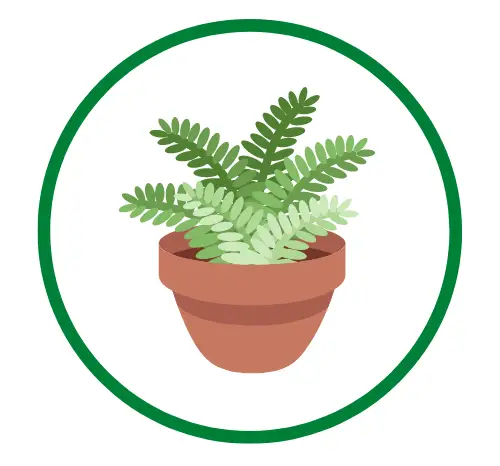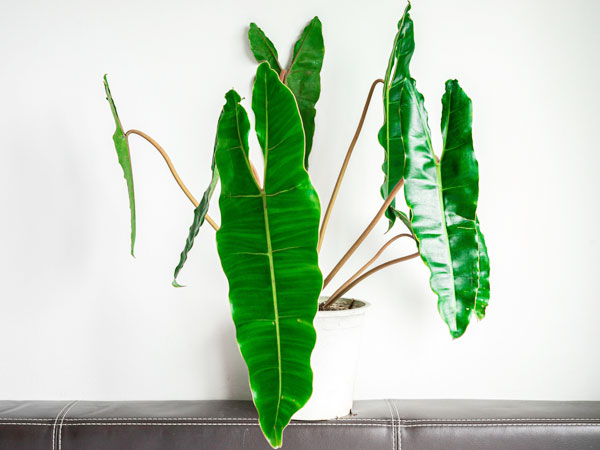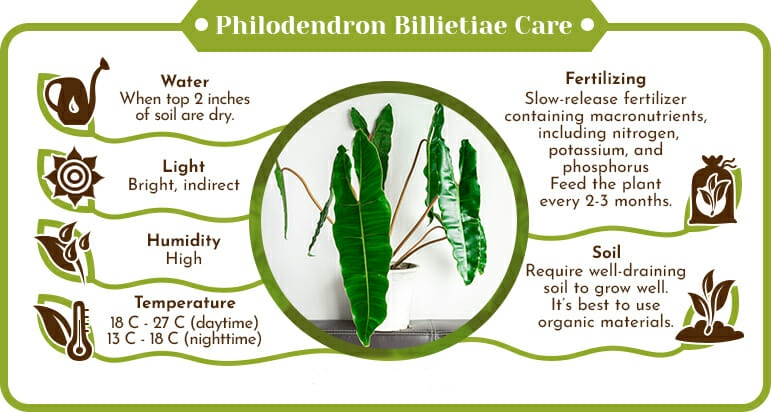Variegated Philodendron Billietiae: How to Properly Grow & Care For It
Variegated philodendron billietiae is a sub-variety of the beautiful philodendron plant known among houseplant enthusiasts as one of the most attractive examples of a variegated vine climbing plant.
This plant has the impressive and distinctive “elephant ear” shape of the Araceae family, which is very desirable and shared by the majority of philodendron plants. The variegated plants in this family of tropical plant types make for a stunning focal point in any home, and it is regarded as an intermediate-level houseplant in terms of care.
Due to their rarity and high price, it can be difficult to find variegated billietiae for sale. The philodendron billietiae plant species, however, require little maintenance. They simply require a setting that is more tightly controlled and regulated, and their care has a very small margin for error.
If the plant receives the proper lighting, soil conditions, moisture levels, and general care, it can thrive. This care manual will give you all the information you need to take good care of your philodendron billietiae, from daily routines to things to do every few weeks. So let’s get started right away!
What is a Variegated philodendron billietiae tropical plant?
Aroid perennial philodendron billietiae vines can reach heights of up to five feet. It belongs to the Araceae family and the Philodendron genus, which Frieda Billiet only recently discovered in the early 1980s. It is indigenous to countries like Brazil, Costa Rica, and French Guiana and originates from tropical rainforests.
YOU CAN BUY HERE
Size and Structure philodendron billietiae plant
In ideal circumstances, these plants will expand to the maximum size permitted by their surroundings. The size of the pot and location in the house are frequently restrictions indoors. They can occasionally grow more than five feet if they are grown outdoors in warmer climates with tall trees.
Leaves
The arrowhead-shaped leaves of this plant develop wavy or crinkly edges with aging. Although the majority of houseplant species are smaller, mature leaves can reach lengths of over 3 feet and 10 inches.
Healthy or Root Rot
The philodendron billietiae can grow as an epiphyte or a semi-epiphyte due to the abundance of aerial roots. The numerous underground roots supply nutrients from the ground, while the external roots cling to poles and other climbing surfaces.
Flowers
Although it happens very infrequently for indoor specimens of these plants, they do produce flowers. If it does bloom, the warmer months will see the greatest prevalence of white or off-white flowers. They have standard spathe and spadix configurations.
Is It Toxic?
These plants contain calcium oxalate, which makes them poisonous. Stomach issues may result from consumption, and the sap may irritate the skin. To prevent potential poisoning issues, make sure the plant is kept out of the reach of children and pets.
Variegated Vine Climbing Plant
This sub-variety offers leaves with an eye-catching size and shape along with additional white to cream-colored patches. The only difference in the environment that the variegated philodendron billietiae needs is brighter light to preserve its variegation.
The way you treat this plant will directly affect how it grows, so taking the proper care of both the regular and variegated varieties will guarantee your success.
Basics of Variegated Philodendron Billietiae Care
Ideal Soil Type
Similar to other Philodendron plants, this plant will require well-draining soil to grow well. It’s best to use organic materials for the plant.
The excess water in the soil can drain out while the soil still retains moisture for your plant’s hydration needs. If the soil is too wet, oxygen cannot reach the roots and other important areas because the soil is unable to absorb it. This is why using well-draining soil to maintain a balance between hydration and moisture is advised.
You can mix equal parts of soybean meal, perlite, sphagnum peat moss (peat moss), and compost. This is one of the suitable potting mixtures for this plant’s well-draining soil.
Lighting Needs
Bright indirect light is required for the philodendron billietiae. Although it receives shade from trees and taller plants, since these plants are native to tropical rainforests, they need sunlight.
Do NOT expose your plant to direct sunlight. They will probably burn if left unattended for too long, with the leaves of the philodendron billietiae developing scorch marks. To grow well, the plant will need bright sunlight, especially since they are known for their large leaves.
It’s simple to provide them with the right lighting. Just put your plant in windows that face north or east. If you choose to give your plant artificial light, make sure to set it off to the side by a few inches so the light doesn’t hit it directly. To make sure all of the plant’s leaves receive enough light, rotate it every three to five days.
In light of the foregoing, avoid placing your plant too far from its light source. The plant gets less light the further away it is.
Drainage Needs
A good drainage system is essential because plant roots grow in and out of the soil. This variety is especially prone to root rot and other overwatering-related problems. Thus, the best course of action is to prevent problems from arising in the first place.
Pot Size
Your plant’s growth and health will be directly impacted by the size of the pot. By limiting root expansion, smaller pots will prevent your plant from growing too large. However, the plant will begin to wilt and fade if the roots are overly confined in a small pot.
Any container that is only slightly larger than the plant’s roots will do. For potting, plastic, terracotta, and clay are all acceptable materials, and the pot needs to have drainage holes. You might have to create your own if there aren’t.
The Philodendron Billietiae does not enjoy sitting in water and is susceptible to root rot.
Also read Best Pots For Carnivorous Plants
Watering Needs (philodendron billietiae care)
The philodendron billietiae needs moist soil to grow properly, NOT saturated soil. This is true for all plants.
This plant prefers moist soil, so it shouldn’t be allowed to get so dry that the leaves start to wilt. However, drenched soil is also bad because it damages the roots and allows root rot to develop, which quickly kills the plant.
Your plant may experience a number of issues, some of which could lead to the plant’s death, if the soil is too wet. Root rot, which is brought on by overwatering, is one of the biggest issues. However, if root rot is discovered early, the plant can be saved.
Unfortunately, the symptoms of root rot aren’t always easy to see above the soil, and when they do, gardeners might mistake them for other problems.
Because of this, it’s more crucial to avoid these situations and properly water your plant. You can do this by putting your finger in the soil and feeling how moist or dry it is first. Put your finger up to your knuckle or 2 inches into the ground.
You must water the plant if the soil feels completely dry to the tip of your finger. If the top few inches of soil are still damp, do not water it because you risk overwatering. The same is true if you don’t water your plant; underwatering has similar effects.
Temperature Range
Temperatures between 18 and 27 degrees Celsius during the day and 13 to 18 degrees Celsius at night are ideal for the philodendron billietiae’s growth. The plant cannot tolerate frost or temperatures below 13 degrees Celsius, so avoid exposing it to them.
As it originates from warm climates that carry moisture around, this tropical plant needs high humidity levels when discussing temperature ranges.
You must make sure the environment in which your plant grows has high humidity levels. Fortunately, it’s simple to raise the humidity at home.
You can do this by filling a tray with pebbles and water, but not so much that the water covers the stones. On this pebble tray, put the plant. Your plant can absorb all of the moisture that is created when the water in the tray slowly evaporates, creating a moist environment around it.
You can also mist or spray your leaves with water from a spray bottle, but avoid soaking or saturating them because doing so could result in fungus issues and leaves covered in numerous odd lesions. However, it might not be as effective as the pebble tray method.
You would need to follow a strict schedule because it is impossible to accurately track the humidity levels. A humidifier is an additional choice that gives you more control over the humidity levels.
Humidity Needs
These plants require humidity indoors and will flourish in conditions of average to high humidity.
Increased humidity can be achieved by using humidifiers or a pebble tray with water placed close to the plant pot. Indoor air will become dry as a result of heating and air conditioning, so this is crucial.
Also read 5 Best Humidifiers For Plants Reviews
Fertilizer
The philodendrons require a lot of nitrogen fertilizers because they are foliage plants. Every two to three months, you can add slow-release fertilizer. Every 4-6 weeks, a foliage plant fertilizer can be combined with water, diluted to half strength, and applied to ensure slow absorption by the plant.
Following these simple maintenance guidelines can help to keep your plant strong and healthy so that it can withstand common plant diseases and other problems. Naturally, mature plant specimens require more room and water, and taller plants will require more care and attention to ensure the plant grows strong and healthily.
These care fundamentals, from new and healthy leaves and mature leaves to healthy roots and strong roots, will be greatly appreciated by your plant.
How to Propagate Philodendron Billietiae Indoors
Compared to other common houseplants, the growth of these plants can be relatively slow, but their growing season can be quite active during the warmer months. These plants flourish in an environment where they can spread their leaves and roots, just like other philodendron species do.
They will grow trees and other environmental features in their natural habitat, which are tropical rainforests. Aerial roots that help the plant anchor itself and absorb nutrients and moisture will develop at a leaf node. You need to recreate that environment indoors.
The best light for the plant is indirect light rather than direct sunlight, and you should keep it away from drafty areas where the air conditioner or heater will affect it. You will succeed greatly if you use the advice given here.
In order to enjoy more Philodendron billietiae, you may occasionally want to try propagating your plant. You have two options for philodendron plant propagation: stem cuttings and air layering.
When taking a stem cutting, a portion of the stem that includes at least a few leaves and aerial roots is removed. The cuttings can be planted in a fresh pot and developed into a new plant that is identical to the parent.
The part in a small stem area is removed during the air layering process. The area will then be covered in peat moss or sphagnum moss and kept moist so that roots can start to form. You can cut away the plant’s foliage and pot it up as usual once the roots are apparent.
Remember that the plant’s sap can be toxic no matter how you go about propagating it. It is essential to put on gloves and wash your hands afterward. The most effective way to steer clear of skin allergies and unintentional ingestion.
Lower indirect light can help prevent additional stress as cuttings and new plants establish themselves and develop fresh, healthy leaves. Where the new plant was removed from the mother plant, the wound ought to mend quickly.
To ensure that no rot or other problems develop, it is still worth keeping an eye on it for the first week. This rare philodendron will root more quickly and more successfully if you use a rooting hormone compound for both propagation techniques.
Plant Pests and Plant Diseases
This is a relatively hardy plant that thankfully has minimal issues with pests and diseases, especially when compared to other indoor plants.
Plant Pests
There are only a select few pests that can cause a plant to become infected, including:
Aphids
The pear-shaped insects known as aphids assemble at leaf nodes and on new growth. These pests would feed on the sap in your plant, sucking out water and nutrients with their needle-like noses. This stresses out your plant a lot and deprives it of essential nutrients for good health and aesthetics.
Mealybugs
Mealybugs are uncommon insect pests that are simple to recognize thanks to the cotton-like material covering them. Additionally, these pests consume plant sap, piercing the plant and ingesting the nutrients directly. If left untreated, a bad infestation can cause stunted growth or even plant death.
Plant Diseases
Philodendron plants are resilient plants however, some of the diseases they might experience are:
Cold Shock
Your plant is suffering from a cold shock if it suddenly starts to produce white or pale-colored leaves that are droopy and look wilted. The leaves will suffer damage from exposure to low temperatures, often irreparable damage.
The leaves of your plants will remain glossy and healthy-looking if you keep them in a warm, humid environment.
Magnesium Deficiency
Magnesium deficiency is the last problem to watch out for with these tropical plants. A deficiency in this crucial nutrient can cause the leaves to develop what appears to be a V-shaped stain.
If left untreated, it may cause brown necrosis, which causes the affected leaves to die, and eventually, root rot may cause the death of the entire plant.
Conclusion
Many members of the tropical foliage plant family Araceae are immune to common maladies and pest infestation. Every few weeks, though, careful observation is required. Even though they don’t cause much concern, the problems that can affect variegated philodendron billietiae can quickly result in plant death if left untreated.
This plant can make a wonderful specimen to display in your home, which is why it is still a popular option today!
Care for Philodendron billietiae is comparatively simple. With this manual in hand, you can be sure that you will be able to add variegated billietiae for sale to your collection with confidence when you come across them.




















